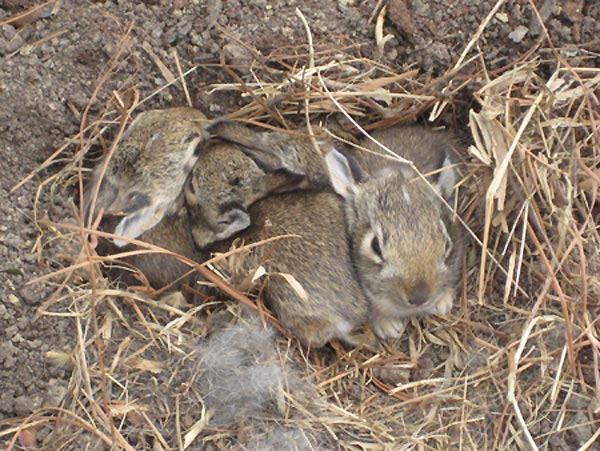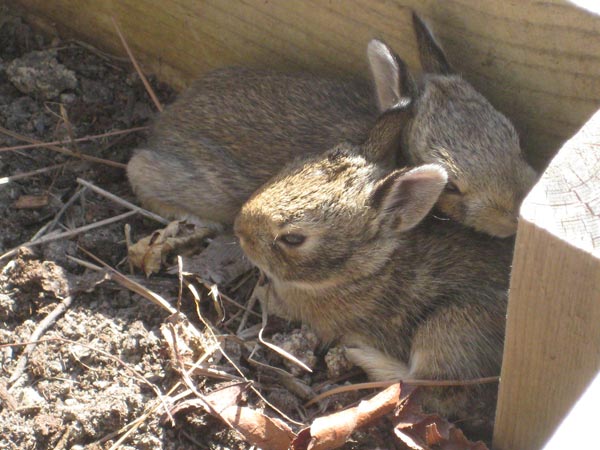What Peter Cottontail Won’t Tell Youby Herta Rodina
|
|
‘Tis the season for baby cottontails! The Buckeye HRS deals with
domestic rabbits only, but nevertheless we get many panicked calls and emails
when someone (or his dog or cat or lawnmower) accidentally disturbs a wild
rabbit nest. If you ever find yourself in this unfortunate position, here are a
few tips to keep in mind. If the baby rabbits are not injured and the nest is intact, do not intervene. Because rabbit milk is so rich, mother cottontails nurse their young for only a few minutes a day, usually at dawn or dusk. It is perfectly normal not to see mom around, since she does not sit on the nest to protect her babies or keep them warm. Even though they look tiny and helpless, letting nature take its course ensures their best chances for survival. If the nest has been disturbed, replace as much of the original material as possible in a shallow depression in the ground. Add dried grass and leaves to make a soft bed and return uninjured babies to the nest. Keep any domestic animals away from the area until the babies have left. If the babies have been injured, contact a wildlife rehabilitator immediately. For a list of local rehabbers, visit the Ohio Wildlife Rehabilitators Association -- or call your local Ohio Department of Natural Resources office. After hours, contact your local emergency vet clinic; they may be able to help until you can contact an experienced rehabber.
It’s a sad fact of nature that most baby cottontails will not see a second spring, but by knowing when and where to get assistance and how to prevent accidents, you can help stack the odds in their favor.
|
|
For more information about baby wild rabbits, visit the following websites:
|
|
|
|
This page is maintained by David Sharpe (www.ohio.edu/people/sharpe)
|
 The Buckeye House Rabbit Society
The Buckeye House Rabbit Society
 As with most aspects of life, an ounce of prevention is worth a
pound of cure. Take a walk through your lawn before you mow, so that you can cut
around a rabbit nest. Keep domestic cats indoors, where they can’t pose a threat
to outdoor wildlife. Refrain from using chemicals and pesticides on your yard,
for these can be fatal to baby rabbits. Finally, provide protective cover for
growing babies by building a brush pile in a corner of your property and by
planting low-lying bushes and shrubs. These natural shelters may mean the
difference between life and death when a baby rabbit is trying to escape from
the talons of a hawk or the jaws of a fox or raccoon.
As with most aspects of life, an ounce of prevention is worth a
pound of cure. Take a walk through your lawn before you mow, so that you can cut
around a rabbit nest. Keep domestic cats indoors, where they can’t pose a threat
to outdoor wildlife. Refrain from using chemicals and pesticides on your yard,
for these can be fatal to baby rabbits. Finally, provide protective cover for
growing babies by building a brush pile in a corner of your property and by
planting low-lying bushes and shrubs. These natural shelters may mean the
difference between life and death when a baby rabbit is trying to escape from
the talons of a hawk or the jaws of a fox or raccoon.